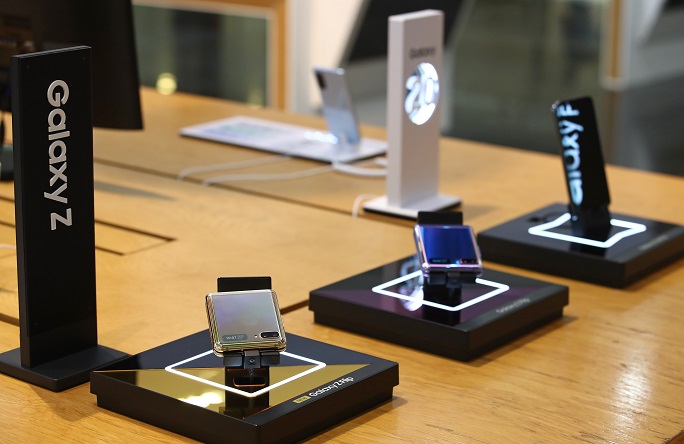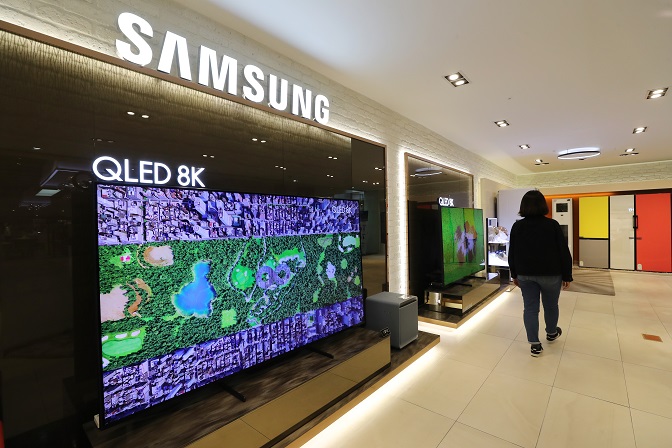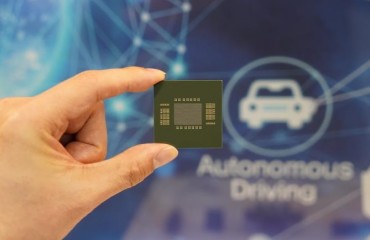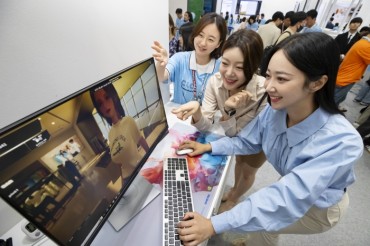
This photo, taken on April 7, 2020, shows the outdoor signage of Samsung Electronics Co. at its office building in Seoul. (Yonhap)
SEOUL, July 30 (Korea Bizwire) — Samsung Electronics Co. said Thursday it expects solid demand of chips and a gradual recovery in the mobile phone sector in the second half of the year as the world’s largest memory chipmaker racked up strong second-quarter earnings.
Samsung’s net profit stood at 5.55 trillion won (US$4.7 billion) in the April-June period, up 7.23 percent from a year earlier, the South Korean tech giant said in a regulatory filing.
Its operating profit jumped 23.5 percent on-year to 8.15 trillion won in the second quarter of the year, but sales fell 5.6 percent on-year to 52.97 trillion won over the cited period.
Samsung’s operating margin for the second quarter stood at 15.4 percent, the highest since the fourth quarter of 2018.
Compared to the first quarter, its operating profit soared 26.3 percent, while net profit rose 13.7 percent. Sales declined 4.3 percent
The figures were in line with the earnings guidance announced earlier this month that beat the market consensus.
Samsung said its upbeat performance was anchored by its device solutions (DS) division as demand for memory chips from data centers remained solid with the pandemic-driven, stay-at-home trend.
The second-quarter bottom line was also helped by one-time gains from its display panel (DP) business.
Samsung did not disclose the exact amount of one-off profit, but industry insiders speculate it received more than $900 million from Apple Inc., which apparently failed to buy contracted volumes of Samsung Display Co.’s mobile display panels.
Looking to the second half, Samsung expects solid demand of memory chips helped by new smartphones and gaming console launches.
“Overall demand for DRAM is expected to pick up from new smartphone launches, while uncertainties remain around geopolitical issues, including trade disputes and the pace of higher content-per-box adoption,” it said.
“As for NAND, mobile demand is expected to recover on the back of growing mid- to low-end products despite continuing uncertainties.”

This photo provided by Samsung Electronics Co. on May 21, 2020, shows the company’s chip plant in Pyeongtaek, south of Seoul.
The company also projected a gradual recovery in demand for its mobile devices, with a sales increase expected in the current quarter. Samsung will introduce its new flagship mobile devices, including the Galaxy Note 20 and the Galaxy Z Fold 2, next week.
Samsung also expected improved earnings from the Consumer Electronics (CE) division with sales of premium products.
“For the second half of the year, both TVs and digital appliances are expected to see better performance in sales compared with the first-half results once COVID-19 lockdowns ease and year-end holiday spending gathers pace,” it said.
For its display business, Samsung predicted “a full-fledged rebound” in earnings in the fourth quarter of the year, citing a recovery in mobile phone demand during the third quarter will likely be limited to budget models.
In the second quarter of the year, revenue from the semiconductor unit stood at 18.23 trillion won, up 13.3 percent from a year earlier. Its operating profit from the chip business nearly doubled to 5.43 trillion won from 3.4 trillion won a year ago.
“The memory business saw robust demand for cloud applications related to remote working and online education as the impact from COVID-19 continued, while demand for mobile was relatively weak,” Samsung said.
For DRAM, Samsung said the bit growth increased by a low single-digit percentage in the second quarter, with its average selling price (ASP) rising by around 10 percent. In the third quarter, Samsung expects DRAM bit growth to be flat.
Bit growth refers to the amount of memory produced and is considered a key barometer to gauge market demand.
For NAND, Samsung said the bit growth declined by a low single-digit percentage, but its ASP climbed by a percentage in the mid-single digits.
In the third quarter, market growth for NAND is expected to be in the mid-single digits, but Samsung said its performance could be better than that.
Samsung added its inventory for both DRAM and NAND are at normal levels.

his photo taken July 7, 2020, shows Samsung Electronics Co.’s foldable smartphones displayed at a store in Seoul. (Yonhap)
On its outlook for Double Data Rate 5 (DDR5) DRAM, Samsung expects the next-generation memory to be released in the second half of 2021, and crossover with DDR4 could happen in late 2023.
Samsung said earnings for its system LSI business fell due to a drop in demand for mobile components. However, its foundry business achieved a record quarterly and half-yearly revenue as its customers’ inventory buildups increased.
Its foundry unit has begun mass production of 5-nanometer (nm) products, according to Samsung. It denied rumors of skipping the 4nm process, saying the company is developing 4nm process technology as planned.
Samsung’s display business returned to the black, thanks to one-time gains. It logged 6.72 trillion won in sales and an operating profit of 300 billion won.
Its display business suffered an operating loss of 290 billion won in the first quarter.
Samsung said OLED panels accounted more than 80 percent of the unit’s sales in the second quarter.
Samsung’s IT & Mobile Communications (IM) division suffered a sales decline, but its performance was better than expected.
The mobile business unit posted 20.75 trillion won in sales in the second quarter, down 19.7 percent from a year earlier, but the unit’s operating profit surged 25 percent on-year to 1.95 trillion won.
“Efficient cost management, including reductions of marketing expenses and offline promotions, helped deliver solid profits,” the company said.
Samsung said it sold 57 million units of handsets in the second quarter, with around 95 percent of them being smartphones. ASP for its devices, including tablets, was at $226.
According to market tracker Canalys, Samsung was edged by China’s Huawei Technologies Co. in the second quarter of the year to lose its status as the world’s largest smartphone vendor.
It estimated that Huawei shipped 55.8 million devices, outnumbering Samsung’s 53.7 million units.
In the third quarter, Samsung expected shipments to increase for both handsets and tablets, as well as a rise in ASP.

This file photo taken April 29, 2020, shows Samsung Electronics Co.’s QLED 8K TVs displayed at a store in Seoul. (Yonhap)
Samsung’s home appliance division, comprised of visual display and digital appliance businesses, chalked up sales of 10.17 trillion won, down 8.1 percent from a year earlier, but operating profit climbed 2.8 percent on-year to 730 billion won.
“Profit for the visual display business rose despite softness in sales as the company sought new sales opportunities online to overcome difficulties sparked by global lockdowns,” the company said.
“Seasonal demand for air conditioners on top of cost-effective marketing strategies also helped earnings.”
Samsung said its TV sales volume declined by around 15 percent in the second quarter of the year, but it expected to rise by at least 40 percent in the third quarter.
Samsung assessed uncertainties from the pandemic and growing competition remain in the second half of the year, but it will try to boost demand through flexible global supply chain management to ensure a timely supply to customers.
For its chip business, Samsung said it will focus on reinforcing its technological prowess in DRAM with application of 1Z-nm and extreme ultraviolet (EUV) lithography-based products.
For NAND, the company plans to improve its cost competitiveness and accelerate conversion to 6th-generation V-NAND.
For the mobile business, Samsung said it will try to improve profitability through optimizing product portfolio, with focus on boosting its mass-market lineup.
In the second quarter, Samsung said its capital expenditures reached 9.8 trillion won, which includes 8.6 trillion won spent on semiconductors and 0.8 trillion won on displays. Its total capital expenditures in the first half were tallied at 17.1 trillion won.
Samsung said investment in the memory business was mainly spent on equipment for capacity expansion and finer process technology. For the foundry business, the company focused on beefing up its 5-and 8-nm processes.
Meanwhile, Samsung said it will pay 354 won in dividends per share, delivering a total of 2.4 trillion won to its shareholders.
Shares in Samsung ended flat at 59,000 won on the Seoul bourse, underperforming the broader KOSPI’s 0.17 percent increase. Its earnings results were released before the stock market opened.
(Yonhap)






